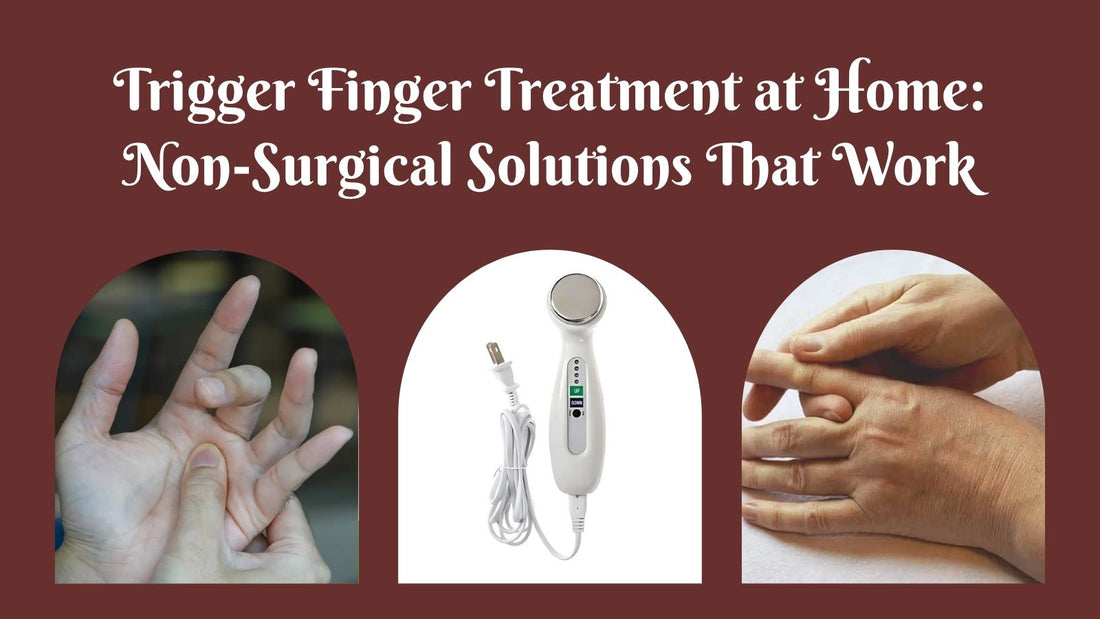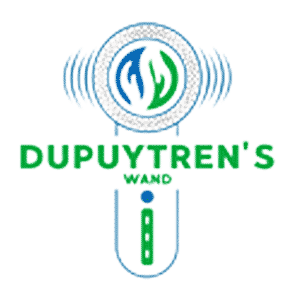
Trigger Finger Treatment at Home: Non-Surgical Solutions That Work
Share
If you're reading this, chances are you're dealing with the frustrating reality of trigger finger – that uncomfortable sensation when your finger gets stuck in a bent position and then suddenly "pops" straight. You're not alone.
Trigger finger affects millions of people worldwide, and while surgery is often presented as the primary solution, there are effective and proven trigger finger treatment without surgery methods that can provide significant relief from the comfort of your own home.
Understanding Why Your Finger "Triggers"
It is important to familiarize yourself with what is happening to your finger before trying out any form of remedy. Trigger finger is also called stenosing tenosynovitis, and one of the factors that causes the illness is inflammation and thickening of the protective sheath
1. Targeted Heat and Ultrasound Therapy
Ultrasound therapy is a professional-class therapy that has demonstrated outstanding outcomes concerning the treatment of trigger finger by stimulating tissue healing and relieving inflammation. Being initially developed to treat the Dupuytren contracture, the Dupuytren Wand helps to use the benefits of far infrared heat and the power of ultrasound simultaneously, as they penetrate deeply into the layers of tissues.
How it works for trigger finger:
The vibrations caused by the ultrasound waves enhance the blood circulation on the microscopic level.
Far infrared heat makes tissues supple and decreases tissue rigidity
The force of combined therapy is useful in dissolving the formation of scar tissue within the tendon sheath
Application technique:
Put conductive gel on the afflicted finger
Expand the device, 10-15 minutes on the palm side of your finger, a place where you feel the catch and the sensation thereof
Make motions slow and circular with the device to be sure the heat can spread evenly
After that, continue with soft stretching exercises
2. Splinting Strategy That Works
Trigger finger splinting is different compared to splinting a generic finger in the sense that a special approach must be used:
Night splinting: Put your involved finger in an extended position when you sleep to avoid capture and morning stiffness. This gives the inflamed tendon sheath a rest and heals well.
Activity modification splinting: This is during an activity the person knows causes symptoms by employing a lightweight splint, which holds the fingers slightly extended but still permits them to be used during brisk activities.
3. Progressive Stretching Protocol
Random finger exercises won't solve trigger finger – you need a systematic approach:
Phase 1 (Acute stage):
Gentle finger extension holds: 10 seconds, 10 repetitions
Passive range of motion with your other hand
Focus on pain-free movement only
Phase 2 (Improvement stage):
Active finger flexion and extension: 15 repetitions, 3 sets
Tendon gliding exercises: Move fingers from straight to hook position
Grip strengthening with soft stress ball
Phase 3 (Recovery stage):
Resistance exercises using rubber bands
Functional movement patterns
Gradual return to normal activities
4. Anti-Inflammatory Nutrition Approach
Your diet directly impacts inflammation levels throughout your body, including your finger tendons:
Include these foods:
Omega-3 rich fish (salmon, mackerel, sardines)
Leafy green vegetables high in antioxidants
Berries containing natural anti-inflammatory compounds
Turmeric and ginger for their curcumin and gingerol content
Avoid these triggers:
Processed foods high in trans fats
Excessive sugar that promotes inflammation
Refined carbohydrates that spike blood sugar
Alcohol, which can interfere with healing
The Dupuytren's Wand Advantage for Trigger Finger
Though initially the Dupuytren's Wand was conceived as an instrument to treat Dupuytren contracture, it also has special advantages to the victim of trigger finger:
Dual-action treatment: The union of ultrasound technology and far infrared has a punctual approach to treat the inflammation as well as the mechanical constriction of your finger.
Regular treatment: You are able to do a continuous treatment at home, unlike the clinic visit,s and it is very essential in healing trigger finger.
Cost-effectiveness: The equipment gets paid off in a matter of uses when compared to several sessions of physical therapy or visits to the doctor.
Niche use: Since the device is compact, it offers the advantage of treating the affected tendon area with precision and therefore derives the maximum therapeutic effect.
Creating Your Home Treatment Routine
Week 1-2: Inflammation Control
Morning: 10-minute Dupuytren's Wand session + gentle stretching
Evening: Ice therapy for 15 minutes + night splinting
Throughout day: Activity modification and frequent finger position changes
Week 3-4: Mobility Restoration
Morning: 15-minute device session + progressive stretching
Midday: Tendon gliding exercises (5 minutes)
Evening: Resistance exercises + night splinting
Weeks 5-8: Strength and Function
Morning: Device session + functional exercises
Throughout the day: Gradual return to normal activities
Evening: Maintenance exercises + optional splinting
Measuring Your Progress
Track these key indicators to monitor improvement:
Symptom tracking:
Frequency of catching episodes (daily log)
Pain levels on a 1-10 scale
Morning stiffness duration
Functional limitations (writing, gripping, etc.)
Objective measurements:
Finger range of motion using a smartphone app
Grip strength with a dynamometer
Time to perform specific tasks (buttoning shirt, writing)
When to Seek Professional Help
While home treatment is highly effective, certain situations require medical attention:
No improvement after 6-8 weeks of consistent treatment
Increasing pain or swelling
Complete finger locking that doesn't release
Signs of infection (redness, warmth, fever)
Numbness or tingling indicating nerve involvement
Long-Term Prevention Strategies
Successfully treating trigger finger is only half the battle – preventing recurrence is equally important:
Workplace modifications:
Use ergonomic tools with larger grips
Take regular breaks from repetitive tasks
Alternate hands when possible
Maintain neutral wrist positions
Lifestyle adjustments:
Regular hand and finger stretching throughout the day
Maintain healthy weight to reduce the inflammatory burden
Stay hydrated to support tissue health
Manage underlying conditions like diabetes or arthritis
The Bottom Line
Trigger finger treatment at home isn't just possible – it's often the most effective approach when done correctly. The trick is regularity, good form and tools such as the Dupuytren's Wand to correct the hidden inflammation and mechanical limitations.
It is important to remember that each case of trigger finger is individual, and what is best can be different in different people. But a combination of targeted ultrasound therapy, correct splinting with progressive exercises and lifestyle improvements has the most successful outcome in the non-surgical intervention.
When you have trigger finger, you should not allow it to ruin your day-to-day activities. When done properly and with a belief that you should continue to exercise trigger finger at home, you will be back to full finger functionality and with no need to resort to surgery. Note that you can begin your course of treatment at home now, and your fingers will appreciate it.
